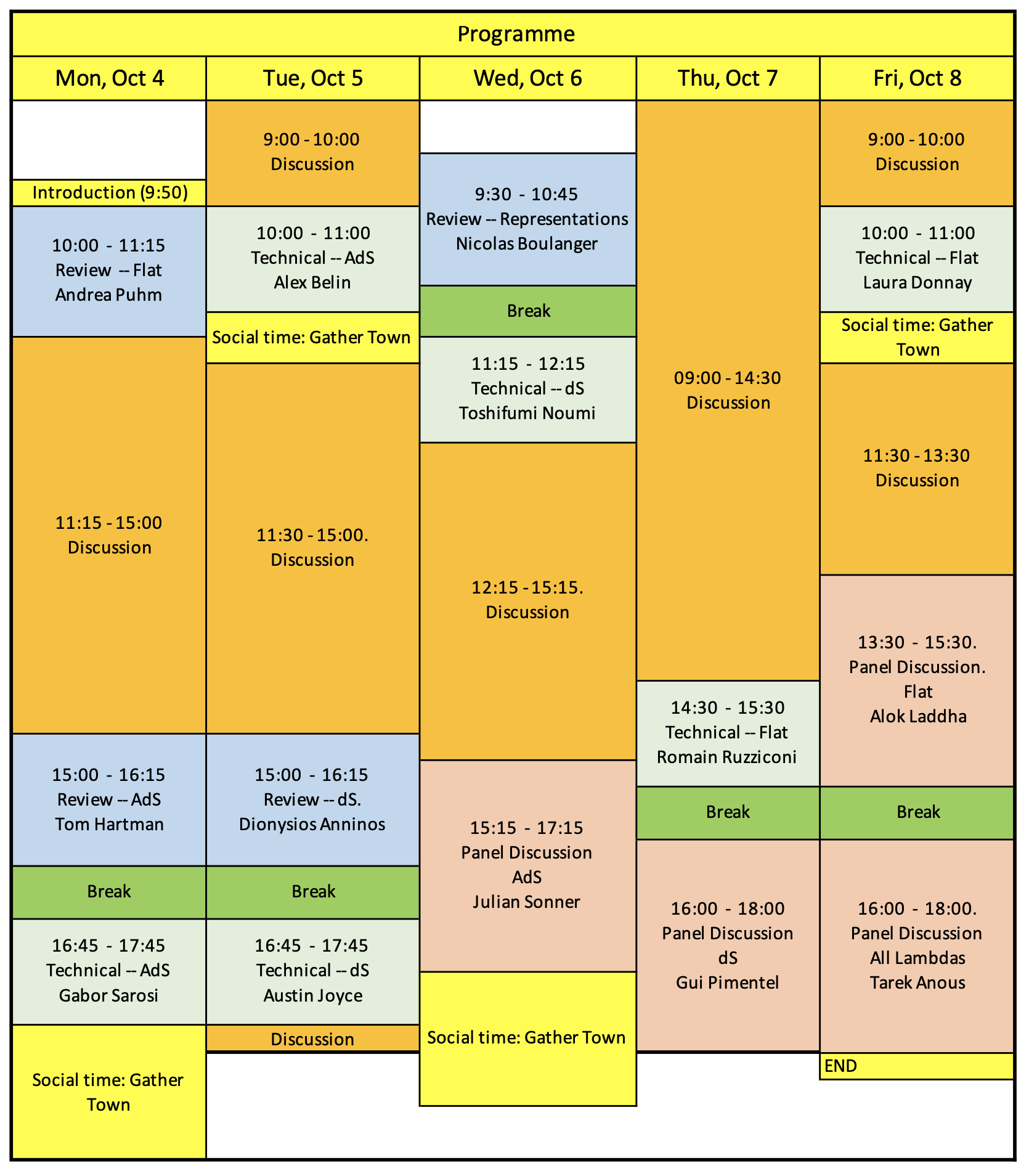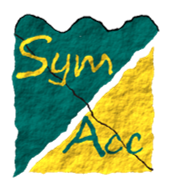| SPEAKER |
INSTITUTE |
TOPIC |
|
Alexandre Belin
|
CERN
|
Bootstrapping Quantum Extremal Surfaces
Quantum extremal surfaces are central to the connection between quantum information theory and quantum gravity and they have played a prominent role in the recent progress on the information paradox. In this talk, I will present a program to systematically link these surfaces to the microscopic data of the dual conformal field theory, namely the scaling dimensions of local operators and their OPE coefficients. I will consider CFT states obtained by acting on the vacuum with single-trace operators, which are dual to one-particle states of the bulk theory. Focusing on AdS3/CFT2, I will compute the CFT entanglement entropy to second order in the large c expansion where quantum extremality becomes important and match it to the expectation value of the bulk area operator. I will show that to this order, the Virasoro identity block contributes solely to the area operator.
|
Laura Donnay
|
Vienna TU
|
BMS flux algebra in celestial holography
In this talk, we construct the BMS momentum fluxes, which are given by non-local expressions of the solution space of asymptotically flat spacetimes. They transform in the coadjoint representation of the extended BMS group and correspond to Virasoro primaries under the action of bulk superrotations. We will also discuss their relation with celestial CFT currents and deduce the OPEs of the celestial CFT operators from the BMS flux algebra.
|
|
Austin Joyce
|
U. Chicago
|
Inflation from the boundary
The large-scale correlations that we observe in the distribution of matter in the universe have their origins in primordial perturbations produced prior to the hot big bang—likely during a period of inflationary expansion. Interestingly we do not directly observe the inflationary epoch, but instead infer its dynamics from correlations residing on the late time boundary of the inflationary spacetime, where the universe reheats. This motivates us to ask whether we can understand things directly on this asymptotic boundary, without making explicit reference to bulk time evolution. I will describe recent progress in this direction, including aspects of how the bulk dynamics is encoded on the boundary.
|
|
Toshifumi Noumi
|
Kobe University
|
String Regge trajectories on de Sitter space
In string theory, higher spin Regge states are crucial for UV completion of gravitational scattering. In this talk, I will discuss similarity and difference of the spectrum of such string Regge states on flat space, anti-de Sitter space, and de Sitter space. In particular, I will demonstrate that each Regge trajectory on de Sitter space has a maximal spin due to causality and existence of the cosmological horizon, which could be a potential obstruction for string theory construction of de Sitter space. Further studies along this line would be useful for better understanding of de Sitter space and dS/CFT in the string theory context.
|
|
Romain Ruzziconi
|
Vienna TU
|
Leaky boundary conditions in holography, BMS fluxes and flat limit
In this talk, I will explain the interest of considering leaky boundary conditions in holography. I will start by presenting generic boundary conditions in asymptotically locally (A)dS spacetimes that yield some flux through the conformal boundary. Then, I will provide a specific example that leads to BMS-like symmetries in presence of non-vanishing cosmological constant. In the flat limit, these symmetries and the associated phase space reduce to those of Generalized BMS in asymptotically flat spacetimes. Finally, I will discuss the BMS flux algebra that has recently been shown to be relevant in the context of celestial holography.
|
|
Gabor Sarosi
|
CERN
|
The volume of the black hole interior at late times
The volume of the interior of a two-sided eternal black hole classically grows forever. I will show that in JT gravity, summing the non-perturbative contribution of higher topologies leads to a saturation of the volume of the interior at times exponential in the entropy of the black hole. I will explain that this is evidence for the conjecture that the size of the interior is related to the complexity of the holographically dual quantum state.
|
| TOPIC |
PANELISTS |
AFFILIATION |
| AdS/CFT --- ABSTRACT HERE --- |
Chair: Julian Sonner |
University of Geneva |
| Daniel Jafferis |
Harvard University |
Jamie Sully |
University of British Columbia |
Erik Verlinde |
University of Amsterdam |
| Flat space holography
Flat Space holography is understood as an attempt to re-write the Quantum gravity S matrix in terms of Correlation functions of a field theory on the boundary. It thus aims to generalise Ads/CFT duality to spacetimes with vanishing cosmological constant. However an asymptotically flat space-time can be conformally completed in many different ways and so there is no unique boundary manifold on which the sought after field theory lives. Part of the boundary which is universal is so-called Null infinity and a lot of effort has gone in developing flat space/field theory correspondence where the field theory lives on null infinity.
At a more fundamental level, holography is premised on the fact that the algebra of boundary observables is isomorphic to the algebra of all gravitational observables. In our Panel discussion, we will focus on both of these aspects of flat space holography and progress that is being made in these directions. |
Chair: Alok Laddha |
Chennai Mathematical Institute (CMI), Chennai |
Jan de Boer |
UvA, Amsterdam |
| Ana-Maria Raclariu |
Perimeter Institute |
Suvrat Raju |
ICTS, Bengaluru |
dS/CFT --- ABSTRACT HERE --- |
Chair: Guilherme Pimentel |
Leiden University and UvA, Amsterdam |
Paolo Benincasa |
Max-Planck-Institut für Physik |
| Enrico Pajer |
University of Cambridge |
Kostas Skenderis |
University of Southampton |
All Lambdas
Holography has been most successful when the curvature of spacetime is negative. The boundary allows for a region where gravity turns off, giving us well-defined observables in the form of CFT correlation functions. In flat space and de Sitter, the problem is more difficult. In the former, it seems as though we need a theory of the S-matrix, whereas in the latter, gravity never seems to turn off. Gravity may still very well be emergent from a lower dimensional theory in these cases, but if so we need to understand the relevant observables in these more difficult cases. In our panel discussion we will discuss the issues of observables and other pertinent questions.
|
Chair: Tarek Anous |
UvA, Amsterdam |
Eliot Hijano |
Princeton University |
| João Penedones |
EPFL, Lausanne |
Loganayagam Ramalingam |
ICTS-TIFR |
| NAME |
INSTITUTE |
| anupam a h | IMSc Chennai |
| Sreehari A P | Indian Institute of Technology Madras |
| Haddad Abdelhamid | Aix-Marseille University |
| Giovanni Acquaviva | Arquimea Research Center |
| Preetham Kumar Adepu | Indian Institute of Science, Bangalore |
| Mir Afrasiar | Indian Institute of Technology Kanpur, India |
| Dmitry Ageev | Steklov Mathematical Institute, RAS |
| Ankit Aggarwal | ULB, UvA |
| Sergio Ernesto Aguilar Gutierrez | KU Leuven |
| Santiago Agüí Salcedo | University of Cambridge |
| Manu Akavoor | Chennai Mathematical Institute, India |
| Shabeeb Alalawi | University of Bonn |
| Soner Albayrak | University of Amsterdam |
| Sevrin Alexander | Vrije Universiteit Brussel |
| Yang An | Zhejiang University of Technology |
| Raclariu Ana-Maria | Perimeter Institute |
| Dionysios Anninos | King's College London |
| Tarek Anous | University of Amsterdam |
| Luis Apolo | University of Amsterdam |
| Delfante Arnaud | UMONS |
| Taha Ayfer | Bogazici University |
| Sourish Banerjee | BITS Goa |
| Pinaki Banerjee | IAS Princeton |
| Jaydeep Kumar Basak | Indian Institute of Technology, Kanpur, India |
| Ivano Basile | UMONS |
| Debarshi Basu | Indian Institute of Technology Kanpur |
| Marianthi Bataki | University of Cyprus |
| Teresa Bautista | King's College London |
| Alex Belin | CERN |
| Aleksandr Belokon | Institute for Nuclear Research, Russian Academy of Sciences |
| Paolo Benincasa | Max-Planck-Institut für Physik |
| Eric Bergshoeff | University of Groningen |
| Klaus Bering | Masaryk U |
| Alice Bernamonti | University of Florence |
| Deepan Betal | Indian Institute of Science Education and Research Bhopal |
| Budhaditya Bhattacharjee | Indian Institute of Science |
| Arindam Bhattacharjee | IISER Pune |
| Aranya Bhattacharya | Indian Institute of Science |
| Parthajit Biswas | IIT Kanpur |
| Eugenia Boffo | Charles University Prague |
| James Bonifacio | University of Cambridge |
| Nicolas Boulanger | UMONS |
| Miguel Campiglia | UdelaR |
| Andrea Campoleoni | University of Mons |
| Federico Capone | University of Southampton |
| Percy Cáceres | Puc Rio de Janeiro |
| Subhroneel Chakrabarti | CEICO, FZU, Prague |
| Tuneer Chakraborty | International Centre for Theoretical Sciences - TIFR |
| Ramesh Chandra | University of Amsterdam |
| Ashish chandra | IIT Kanpur |
| Shira Chapman | Ben Gurion University |
| Arghya Chattopadhyay | University of the Witwatersrand |
| Sangmin Choi | Ecole Polytechnique |
| Chandramouli Chowdhury | ICTS-TIFR |
| Enrico Cinti | University of Urbino/University of Geneva |
| Suchetan Das | IIT Kanpur |
| Jan de Boer | Institute of Theoretical Physics, University of Amsterdam |
| Marchal Dominique | Université Libre de Bruxelles / Service Physique Mathématique / Ingénieur Civil Physicien |
| Laura Donnay | TU Vienna |
| Sarthak Duary | International Centre for Theoretical Sciences, Bangalore |
| Sarthak Duary | International Centre for Theoretical Sciences, Bangalore |
| Carlos Duaso Pueyo | University of Amsterdam |
| Sudipta Dutta | IIT Kanpur |
| Subham Dutta Chowdhury | Tata Institute of Fundamental Research |
| Camille Eloy | VUB |
| William Emond | CEICO, FZU |
| Martin Enriquez Rojo | Arnold Sommerfeld Center - LMU Munich |
| Cem Eröncel | DESY |
| Ricardo Espindola Romero | University of Amsterdam |
| Bobby Ezhuthachan | RKMVERI |
| Kara Farnsworth | Case Western Reserve University |
| Pau Figueras | Queen Mary University of London |
| Adrien Fiorucci | TU Wien |
| Daniel Flores | Cinvestav |
| Thomas Flöss | University of Groningen |
| Stefan Fredenhagen | University of Vienna |
| Laurent Freidel | Perimeter institute |
| Oscar Fuentealba | Université Libre de Bruxelles |
| Damian Galante | King's College London |
| Federico Galli | INFN Florence |
| Bogdan Ganchev | IPhT, Saclay |
| Compère Geoffrey | Université Libre de Bruxelles |
| Silvia Georgescu | IPhT |
| Masoud Ghezelbash | University of Saskatchewan |
| Jewel Ghosh | Independent University Bangladesh (IUB) |
| Marc Gillioz | SISSA |
| Gaston Giribet | University of Buenos Aires |
| Riccardo Gonzo | Trinity College Dublin |
| Harry Goodhew | University of Cambridge |
| Kaberi Goswami | PhD Student |
| Tanguy Grall | University of Cambridge - DAMTP |
| Daniel Grumiller | Institute for Theoretical Physics, TU Wien |
| Philip Hacker | VUB |
| Felix Haehl | IAS Princeton |
| Eleanor Harris | King's College London |
| Tom Hartman | Cornell |
| Guzman Hernandez-Chifflet | UdelaR |
| Eliot Hijano | Princeton University |
| Kurt Hinterbichler | Case Western Reserve University |
| Jack Holden | University of Southampton |
| Sk Jahanur Hoque | Institute of Theoretical Physics, Faculty of Mathematics and Physics, Charles University, Prague. |
| Anthony Houppe | IPhT, CEA Saclay |
| Stanislav Hronek | Masaryk university |
| Ondrej Hulik | VUB |
| MINHAJUL ISLAM | IIT KANPUR |
| Daniel Jafferis | Harvard |
| Aditya Jain | Ashoka University |
| Krishna Jalan | IMSc, Chennai |
| Sadra Jazayeri | IAP, CNRS |
| Hongliang Jiang | QMUL |
| Laura Johnson | ETH Zurich |
| Austin Joyce | University of Chicago |
| Nirmalya Kajuri | IACS, Kolkata |
| Alexandros Kanargias | Johannes Gutenberg University Mainz |
| Sahaja Kanuri | University of Amsterdam |
| Debanjan Karan | IIT Indore |
| Yelda Kardaş | Boğaziçi University |
| Dimitrios Katsinis | NKUA & NCSR Demokritos |
| Mikhail Khramtsov | VUB |
| Petr Kotlařík | Charles University |
| Pavel Krtouš | ITP, FMP, Charles University |
| Arpan Kundu | IMSc, Chennai |
| Alok Laddha | Chennai Mathematical Institute |
| Johannes Lahnsteiner | PhD Student |
| Ricardo Landim | Technical University of Munich |
| Ji Hoon Lee | Perimeter Institute |
| Mang Hei Gordon Lee | University of Cambridge |
| Yixuan Li | IPhT Saclay |
| Arthur Lipstein | Durham University |
| Yan LIU | University Libre de Bruxelles |
| Quim Llorens | ICCUB, Barcelona |
| Daniel Logares Álvarez | Ph.D Student |
| Arshid Lone | Cluster University Of Srinagar Kashmir, India. |
| Kevin Loo | Tsinghua University |
| Sagar Kumar Maity | S N Bose National Center for Basic Sciences |
| Pronobesh Maity | International Centre for Theoretical Sciences, India |
| Sucheta Majumdar | Université Libre de Bruxelles |
| Taniya Mandal | University of the Witwatersrand |
| Arkajyoti Manna | IMSc. |
| Knysh Maria | VUB |
| De Clerck Marine | Vrije Universiteit Brussel |
| Javier Matulich | Université Libre de Bruxelles |
| Sabyasachi Maulik | Saha Institute of Nuclear Physics and Homi Bhabha National Institute |
| Delaram Mirfendereski | University of Texas Rio Grande Valley |
| ABDELMALEK MOHAMMED | Ecole Supérieure de Management de Tlemcen |
| Sukrut Mondkar | Indian Institute of Technology Madras |
| Takato Mori | SOKENDAI, KEK |
| Edward Morvan | University of Amsterdam |
| Beatrix Muhlmann | McGill University |
| JYOTIRMOY MUKHERJEE | Indian Institute of Science |
| Debangshu Mukherjee | IISER Thiruvananthapuram |
| Ivan Munoz | Universidad Catolica de Chile |
| Pratik Nandy | Indian Institute of Science |
| Mrityunjay Nath | IIT Indore |
| Turmoli Neogi | ULB |
| Kevin Nguyen | King's College London |
| Ruggero Noris | CEICO, Institute of Physics of the Czech Academy of Sciences |
| Toshifumi Noumi | Kobe University |
| Prafulla Oak | IACS |
| Roberto Oliveri | CEICO |
| Sergei Ovchinnikov | University of Edinburgh |
| Ogan Özsoy | CEICO, Institute of Physics of the Czech Academy of Sciences |
| Athira P V | Chennai Mathematical Institute |
| enrico Pajer | University of Cambridge |
| Yorgo Pano | CPHT - Ecole Polytechnique |
| Himanshu Parihar | Indian Institute of Technology Kanpur, India |
| Enrico Parisini | University of Southampton |
| Andrei Parnachev | Trinity College Dublin |
| Praneet Pathak | Indian Institute of Science Education and Research Mohali, India |
| Dhruv Pathak | IISER Mohali |
| Milan Patra | National Institute of Science Education and Research, Bhubaneswar |
| Priyadarshi Paul | International Centre for Theoretical Sciences |
| Partha Paul | Chennai Mathematical Institute |
| Simon Pekar | UMONS |
| Joao Penedones | EPFL |
| Benjamin Pethybridge | King's College London |
| Spindel Philippe | UMONS & ULB |
| Gui Pimentel | Leiden University and University of Amsterdam |
| Aaron Poole | University of Southampton |
| Nick Poovuttikul | Durham U. |
| SOMNATH POREY | RKMVERI |
| Siddharth Prabhu | Tata Institute of Fundamental Research |
| Daniele Pranzetti | Perimeter Institute |
| Aneesh Prema Balakrishnan | Institute of Mathematical Sciences, Chennai |
| Tomas Prochazka | FZU |
| Andrea Puhm | CPHT, Ecole Polytechnique |
| Vasilii Pushkarev | unaffiliated |
| Loganayagam R | ICTS-TIFR |
| Joris Raeymaekers | CEICO, FZU, Prague |
| Tabasum Rahnuma | PhD Research scholar, IISER, Bhopal |
| Vinayak Raj | Indian Institute of Technology Kanpur |
| Suvrat Raju | International Centre for Theoretical Sciences (Bengaluru) |
| Pabitra Ray | ICTS-TIFR |
| Anton Rebhan | TU Wien, Vienna, Austria |
| Alan Rios Fukelman | ICC, University of Barcelona |
| Lorenzo Rossi | Queen Mary University of London |
| Paolo Rossi | Charles University |
| Romain Ruzziconi | TU Vienna |
| Muktajyoti Saha | IISER Bhopal |
| SATYABRATA SAHOO | IIT INDORE |
| Marco Sanchioni | University of Urbino |
| Canberk Sanli | Bogazici University |
| Debajyoti Sarkar | Indian Institute of Technology Indore (IITI) |
| Gabor Sarosi | CERN |
| Martin Sasieta | IFT UAM |
| Ignacy Sawicki | CEICO, FZU |
| Martin Schnabl | Ceico, FZU |
| Bhim Sen | IIT INDORE |
| Ali Seraj | ULB |
| Roshan Shankar Kaundinya | IISER Mohali |
| Punit Sharma | Indian Institute of Technology Kanpur, India |
| Aditya Sharma | Indian Institute of Science Education and Research |
| Sanjit Shashi | University of Texas at Austin |
| Omkar Shetye | International Centre of theoretical Sciences |
| Pushkal Shrivastava | Tata Institute of Fundamental Research, Mumbai |
| VIBHOR SINGH | IIT Hyderabad |
| VIBHOR SINGH | IIT HYDERABAD |
| Rajeev Singh | Institute of Nuclear Physics Polish Academy of Sciences, Krakow Poland |
| AKASH SINGH | IISER Mohali |
| Kostas Skenderis | University of Southampton |
| Constantinos Skordis | CEICO, Institute of Physics of the Czech Academy of Sciences |
| Pavel Slepov | Steklov Mathematical Institute, RAS |
| Julian Sonner | University of Geneva |
| David Stefanyszyn | DAMTP, Cambridge |
| Detournay Stephane | ULB |
| Jamie Sully | University of British Columbia |
| Adithya Suresh | IISER Pune |
| Ryo Suzuki | Shing-Tung Yau Center of Southeast University |
| Ota Svitek | Charles University, Prague |
| Abinash Swain | IIT Gandhinagar |
| Gizem Şengör | CEICO, Institute of Physics of the Czech Academy of Sciences |
| Tayebeh Tahamtan | Charles University, Prague |
| Luân Tăng Văn | Vietnam National University Hanoi |
| Heckelbacher Till | LMU Munich |
| Chiara Toldo | Amsterdam U. |
| Marija Tomasevic | University of Barcelona |
| DIEGO TRANCANELLI | USP and UniMORE and INFN Bologna |
| Emilio Trevisani | CPhT Ecole Polytechnique |
| Leonardo Trombetta | CEICO - FZU, Institute of Physics of the Czech Academy of Sciences |
| Caner Unal | Ben-Gurion University |
| Pieter van der Hoek | UvA |
| Erik Verlinde | University of Amsterdam |
| Martin Vincze | Public |
| Stathis Vitouladitis | University of Amsterdam |
| Ward Vleeshouwers | Universiteit van Amsterdam, Universiteit Utrecht |
| Gideon Vos | CEICO, Institute of Physics of the Czech Academy of Sciences |
| Yiting Wang | University of Wisconsin-Madison |
| Timm Wrase | Lehigh University |
| Junbao Wu | Tianjin University |
| Raphaela Wutte | TU Wien |
| Jiabao Yang | Cornell University |
| Nadir Yavuzkan | istanbul University |
| Hai-Qing Zhang | Beihang University |
| Xuao Zhang | KU Leuven |
| Sofia Zhidkova | VUB |
| Céline Zwikel | Perimeter Institute |






